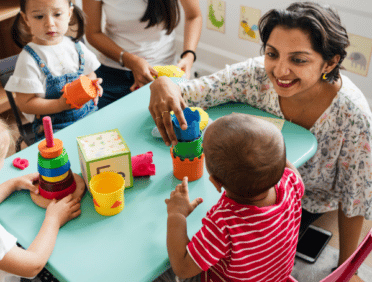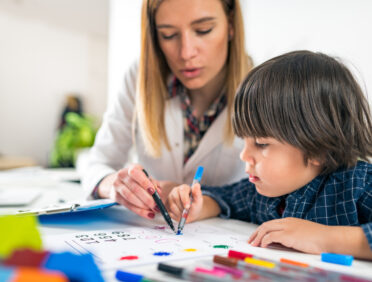If you are somebody who works with or volunteers around children in a school setting, then it’s important to understand that you have key safeguarding responsibilities as part of your job role. To make sure that you fulfil all safeguarding duties properly, you have a responsibility to understand what the law requires of you and to keep up-to-date with any changes or amendments to your responsibilities as outlined by law.
To make sure that the guidance for safeguarding is as clear as possible and to continuously improve upon safeguarding procedures, the government frequently updates and re-visits different safeguarding statutory guidance documents. Consequently, it’s important to be aware of these changes in order to remain compliant and to understand how updates can impact your job.
In addition to the various acts of law that are passed, the government has created further statutory guidance regarding the safeguarding of young people and children. It’s important to understand that these documents contain guidance schools have to follow, as well as guidance that schools should ideally follow.
The government operates under the expectation that schools would need definitive justification for not following any guideline marked as good practice, as this is something they should be doing. However, it is a legal requirement to comply with any guideline marked as “must be done”, and there is no justification that would be appropriate for failing to comply with these terms specifically.
There are two key documents that you should be aware of within your job role that will impact your responsibilities. These are the Working Together to Safeguard Children 2018 and Keeping Children Safe in Education 2022 acts.
These specific documents are updated at regular intervals, so it’s crucial that you familiarise yourself with the current regulations and keep up with the different changes that take place. If you do so, then this will enable you to make changes to your safeguarding policy as necessary or begin to implement new procedures within your organisation to show that you can remain compliant and help to keep children safe from harm.
Let’s take a look at the key statutory documents that are included in this guidance, and provide a brief summary for each one to make sure that you understand what your responsibilities are in this area.
The first document is the Working Together to Safeguard Children guidance. This document is a piece of statutory guidance that outlines the responsibilities all organisations in England have for fulfilling safeguarding towards young people and children, which applies to anybody who is under the age of 18.
This guidance was last updated in 2018 and is aimed at anybody who comes into contact with children and outlines the concept that every individual, agency or organisation is responsible for working together to help safeguard and protect young people and children from harm.
The second piece of guidance is the Keeping Children Safe in Education document. This document contains statutory guidance which is relevant to all education settings, including nurseries, colleges and schools. The document clearly outlines and explains how to fulfil all safeguarding duties and promote the welfare of young people and children, who are defined as anybody under the age of 18.
Who is This Guidance For?
It’s important to understand that when referring to safeguarding guidance, the criteria and information outlined in the documents are applicable to anybody who interacts or works with children.
Safeguarding is based upon the idea that everybody is responsible for protecting children, whether they are directly or indirectly coming into contact with them. This means that the guidance applies not only to teachers and lecturers but also to people who are directly and indirectly coming into contact with children. This can include people like cleaning staff, dinner staff, other parents, volunteers, or health and safety professionals.
Anybody who works in the area where children are and comes into contact with them has a basic responsibility of safeguarding. This means that they are instructed to be not only vigilant to keep an eye out for safeguarding concerns but also be able to report them to the relevant authority.
What School and College Staff Should Know and Do
When it comes to what school and college staff should know when safeguarding, they should have enough training and education to be able to develop a child-oriented and coordinated approach to safeguarding as laid out by the guidelines we will cover.
First of all, it is important to know that colleges and schools, as well as their staff, are an important part of a wider safeguarding system for children, which is outlined properly in the statutory guidance for Working Together to Safeguard Children.
Second of all, the document clearly outlines that the welfare of children is everybody’s responsibility from a safeguarding perspective. Anyone who comes into contact with children or their families has a role to play. In order to effectively fulfil these responsibilities, any practitioner should make sure that the approach they take is child-oriented. Simply put, this means that the best interests of the child should be considered and kept in mind at all times.
The document outlines that no single practitioner is allowed to have a full picture of the circumstances and needs of a child. If both children and families are to receive the correct help at the right time, anybody who comes into contact with them has a responsibility to share information, identify concerns, and take prompt action for the purposes of safeguarding children.
The document also makes clear reference to the fact that safeguarding and promoting the active well-being and welfare of children is defined as the following ideas. Promoting the protection of children from maltreatment, preventing the impairment of children’s physical or mental health and development, making sure that children are allowed to grow up in circumstances that consistently provide them with access to safe and effective care, and taking all action necessary to enable children to have the best outcomes in life.
The Role of School and College Staff
From a safeguarding perspective, college and school staff are a particularly useful resource. They are in a key position to be able to provide help for the children, identify safeguarding concerns early, actively help to promote the welfare of children and prevent safeguarding concerns from escalating into serious situations.
Every staff member has a responsibility to help provide a safe and comfortable environment in which children can learn without the risk of harm. Each staff member should also be prepared to be able to identify specific children who might benefit from early access to support. In this case, early help is agreed to be the provision of offering support as soon as a problem emerges at any point in the life of the child, ranging from the formative years right the way through to being a teenager.
If a staff member has any safeguarding concerns about the welfare of a child, they should follow the guidelines and regulations that have been set out in paragraphs 51 to 67 of the official statutory guidance. Staff members should also be expected to support social workers and any other relevant agency following the referral of safeguarding concerns.
Each school and college should have a specifically chosen safeguarding lead. This safeguarding lead will have a responsibility to provide support to staff members to help them carry out their specific safeguarding responsibilities. This lead will also be the official liaison between other services, such as the local authority or the social care services of the area.
The designated safeguarding representative and their deputies, where applicable, are the ones who are most likely to have a comprehensive picture of safeguarding and will be the most suitable person to advise staff members on responses to safeguarding concerns. The official teacher standards for 2012 state that all teachers have a responsibility to safeguard the well-being of children and to be able to help maintain public trust in teaching as a profession.
What School and College Staff Should be on the Lookout For
Any child can benefit from early access to support. However, school and college staff need to watch out for children who have specific health conditions, mental health needs, education needs, or are showing signs of being drawn to criminal behaviour.
Children who frequently go missing from home, are at risk of modern slavery, radicalisation, or are in a difficult domestic situation should be observed carefully.
All staff members should also be aware of the key indicators of abuse and neglect. They should understand that children can be at risk anywhere. Staff should also be aware that it is rare for one instance of neglect or abuse to be a standalone event, and there are often multiple events taking place.
Staff members should be aware that there is a significant technological component in any safeguarding concerns. Abuse can frequently take place online.
Staff members should also be aware of certain safeguarding issues which can put children at an increased risk of harm. Drugs, alcohol, violence and missing education are all risk factors.
All staff members should be able to identify the core elements of domestic abuse and recognise the impact it can have on safeguarding issues.
Staff members should understand that mental health problems can, in some instances, indicate that a child is at risk of exploitation, abuse or neglect or has suffered from these situations in the past. However, it is also important to understand that only trained professionals should attempt to diagnose mental health problems. The limitation of a staff member is simply to observe and identify those individuals whose behaviour suggests that they are experiencing mental health problems.
Finally, staff members should be aware of the indicators that signalled children are involved with serious or violent crimes. These indicators can include increased absences from education, a change in relationships gravitating towards older people and groups, or signs of unexplainable injuries.
Keeping Children Safe in Education (KCSIE)
This particular guidance applies to all colleges and schools. It is for teachers, staff, governing bodies, head teachers, management committees, and proprietors.
The guidance is designed to identify and explain the legal duties that have to be followed in the safeguarding and prevention of harm to children and young people that are under the age of 18 in full-time education such as college or school.
The information contained within this statutory guidance lays out what a school must do to remain compliant with the laws on protecting children. If the guidance says that colleges and schools should do something, then they have an obligation to do so unless there is a specific and valid reason not to.
Working Together to Safeguard Children
The Working Together to Safeguard Children guidance covers specific legislative requirements that are placed on individual services within the community.
The guidance also provides a clear framework for the three safeguarding partners in the local area. These are defined as the local authority, a clinical commissioning group within that area like the NHS, and the chief officer of police for the law enforcement within that area. These partners have a legal responsibility to work together and coordinate a safeguarding and welfare response that helps to protect local children from harm, including identifying and responding to their needs.
A specific framework for the two child death review partners is also outlined here. These two partners have a responsibility to make arrangements for the reviewing of any deaths of children within the local area and extending that radius to be outside the local area if considered appropriate.
Statutory Children’s Social Care Assessments and Services
In the event that a child is suffering or is likely to be suffering from harm, it is vital that a referral is immediately made to the local authority children’s social care. Referrals should use the local process designed by safeguarding partners.
Local authority children’s social care assessments have a responsibility to consider where children could be harmed in a context outside of the home. Therefore, it is necessary for colleges and schools to offer as much information as they can during the referral process. This allows for any assessment conducted to have all the available evidence to consider and develop an approach that is contextually grounded in addressing the harm.
Any local authority, using other organisations to help where necessary, has a responsibility to make reasonable enquiries under section 47 of the children’s act 1989 if they have reasonable cause to believe that a child is likely to suffer or is suffering significant harm. These enquiries enable them to identify whether they need to take any immediate action to safeguard the child.
It is necessary for anybody who works in an environment where children are present to understand how safeguarding responsibilities apply to them and to be able to use the legislation and guidance laid down in the various acts to inform their everyday actions. This is where Learn Q can provide targeted support and training.
We are more than happy to provide full support and training for your entire team to make sure that they are up-to-date on the latest regulations. Not only that, but we also recommend they seek regular retraining to make sure that they are fully compliant with the latest rules, which we are also happy to provide. As colleges and schools have a legal responsibility to provide safeguarding support, it is necessary to seek out this training and have it completed as soon as possible.
To download a .pdf of this blog, please click here











